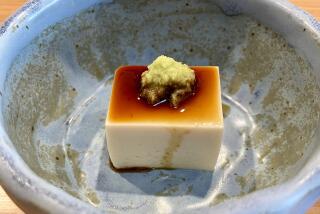New Study Brews Praise for Green Tea
- Share via
HAIBARA, Japan — Promising a taste that will linger for a lifetime, Isaku Watanabe fills a small pot with the best new tea of spring. Then he serves the tea by telling his guests not to drink it.
“Lick it,” he commands. Roll it down the tongue to savor the subtle, even melancholy, blend of sweetness and faint bite, the gentle, grassy scent. Then ponder the aesthetic he hails as the “essence of green.”
“If you gulp it down,” he declares, “you cannot experience green tea.”
Watanabe, president of Kisakuen, a leading producer in Japan’s green tea kingdom of Shizuoka prefecture south of Tokyo, has reason to be rhapsodic these days. A new study by U.S. and Chinese researchers shows that drinking green tea reduces the risk of developing stomach cancer by as much as half.
The study of Shanghai residents by the National Cancer Institute and the Shanghai Cancer Institute, now under review for publication, follows the organizations’ 1994 joint study that found green tea consumption cut the risk of developing esophageal cancer by up to 60%. The reduced risk was determined after adjusting for diet, smoking habits, alcohol consumption and other factors.
In Japan, the brew’s perceived benefits have long been praised if not clearly proven ever since it was introduced from China in the 9th century. Eisai, the founder of Japanese Zen Buddhism, extolled it as the “elixir that creates the mountain-dwelling immortal” in his 1211 tome “Drink Tea and Prolong Life.” And numerous studies in Japan have indicated protective effects against everything from cancer to tooth decay.
For thousands of years, the simple drink has also inspired poetry and philosophy: Chinese aristocrats worshiped this “froth of liquid jade,” and Japanese masters perfected the fabled tea ceremony of flower and scroll, utensil and charcoal, host and guest in a concert of harmony. The Way of Tea, a blend of Zen and Taoist concepts, celebrates the beauty in the mundane, the superiority of spirit over matter, the tranquillity within bustling lives.
Tea has been used to keep meditating Zen monks from falling asleep and to protect sushi eaters from bacterial poisoning. Tea-serving as a humble heart’s graceful expression has, in the age of white-collar industry, also become the symbol of subservience for female office clerks.
But in the past five years, international research on green tea has proliferated, stirring excitement--and visions of new market opportunities--among Watanabe and other growers here. Shizuoka, an idyllic area of clear water and emerald hills, produces half of Japan’s annual tea harvest of 86,000 tons.
Yet few people outside Japan and China drink it regularly; black tea accounts for 80% of world tea consumption although there is no evidence it has the same health benefits. Growers here hope the favorable research will take green tea global.
Since the 1994 Shanghai study, at least three other studies have been conducted on green tea, and they consistently indicate a protective effect, said Joseph McLaughlin, the lead National Cancer Institute researcher on the two studies who now heads the private International Epidemiology Institute in Rockville, Md.
In Shizuoka, research accelerated after a 1985 study found that residents of the town of Nakakawane drank more than seven times the amount of tea and suffered 20% of the stomach cancer rate of the average Japanese. They averaged about 10 cups a day, said the study’s author, food scientist Itaro Oguni.
No one yet knows why green tea could protect health. But most research is focused on tea compounds known as polyphenols, which are believed to combat free radicals, a potentially destructive form of oxygen thought to cause cancer by damaging healthy DNA, McLaughlin said.
However, he said recent findings about the failure of beta carotene--once viewed as a magic bullet--to protect against lung cancer should caution researchers trying to determine which compound out of hundreds may be the protective factor in green tea. He said many more studies are necessary, including a random clinical trial that could take a minimum of five years and cost a few million dollars.
Still, McLaughlin said, the field holds promise.
“Green tea is getting into the category of fruits and vegetables,” he said. “Clearly, a high consumption of fruits and vegetables protects individuals against cancer, and green tea could also be an item that could protect people from certain cancers.”
The U.S. National Institutes of Health, meanwhile, is studying green tea as one of about 40 foods thought to fight disease, along with garlic, carrots, soy, cranberry juice and licorice.
All of which is prompting tea producers here to scramble for new ideas to ride the research boom. Last year, Watanabe constructed Japan’s first green tea wonderland, where visitors can pluck their own leaves and watch them get steamed, rolled, fluffed, dried and packaged in a three-hour process.
The “Greenpia” site--short for Green Utopia--includes a greenhouse of 5,708 tea plants of seven varieties, a two-acre plantation and a factory. A restaurant specializes in such dishes as green tea noodles, tempura and ice cream. A souvenir shop sells tea, related food products, pots and cups.
But Watanabe--whose firm ranks 10th among about 200 Shizuoka tea producers, with annual sales of $27 million--is ultimately eyeing overseas markets. Well aware that Americans are not likely to give up their coffee breaks for green tea--visitors have told him it tastes like grass--he has developed a fine powdered extract to put in food or in capsules.
An associate has developed Western recipes for green tea scrambled eggs, scones, pancakes and muffins. And Watanabe is working with Warner-Lambert Co., the New Jersey-based pharmaceutical firm, to develop green-tea capsules as a potential food supplement. A possible advertising slogan: “Let’s eat tea.”
“If Americans eat this, they’ll extend their lives,” Watanabe says, thrusting forth a handful of experimental tea capsules.
A visit to Greenpia opens a window on Japan’s complex culture of tea--and suggests why the future may indeed be swallow-and-run capsules. The ultimate tea of choice is shincha, or the freshest tea from the new spring plants. It must be selected from the first of four cuttings, known as ichibancha, of the premier Yabukita variety. Such tea sells for $7 an ounce, 10 times the price of standard green tea.
Even if you buy the right tea, properly making it is an entirely different challenge. To pour boiling water directly on the tender leaves constitutes unspeakable barbarism; water must be cooled to about 160 degrees, preferably by pouring it from kettle to container to teapot to cup. The amount of tea and water used, temperature and brewing time are all delicately calibrated and vary depending on the tea variety and quality.
Shizuoka homemaker Kazuyo Sakai, 69, drinks 14 cups of tea daily, experiments with it in recipes, has practiced tea ceremony since childhood and grew up hearing such proverbs as “Tea is the source of long life.” Yet even she still takes lessons on how to make a proper cup of tea.
Growing numbers of Japanese seem to believe it’s a hassle. Consumption of green tea peaked before World War II and began falling as coffee, cola and competing drinks invaded the market. Thanks to a health boom here, tea is back--but in cans, not packages, according to Hidetoshi Akiyama, a spokesman with Seven-Eleven Japan Co. Ltd., the convenience store chain. Today’s go-go youth are less willing to tussle with difficult tea-pouring techniques but still want green tea’s perceived health benefits, he said.
Canned teas now account for 30% of all drink sales, a steady increase over the last several years, while sales of carbonated drinks such as cola and traditional packaged tea are flat, Akiyama said. Nationwide, production of green tea drinks has leaped to 560,000 kiloliters in 1995 from 15,000 in 1988.
Take it from Hiroshi Yaguchi, 31, a new green tea convert now up to four cups a day--thanks to media reports about the benefits and a recent visit to Greenpia.
“It’s better to drink tea than medicine,” he said.
More to Read
Eat your way across L.A.
Get our weekly Tasting Notes newsletter for reviews, news and more.
You may occasionally receive promotional content from the Los Angeles Times.











